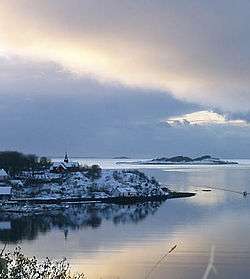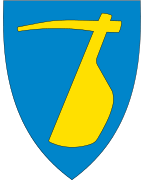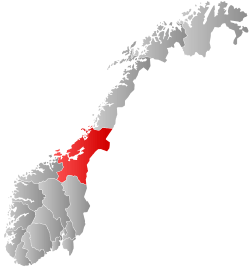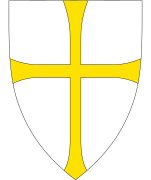Bjugn
| Bjugn kommune | |||
|---|---|---|---|
| Municipality | |||
|
| |||
| |||
 Bjugn within Trøndelag | |||
| Coordinates: 63°48′24″N 09°53′53″E / 63.80667°N 9.89806°ECoordinates: 63°48′24″N 09°53′53″E / 63.80667°N 9.89806°E | |||
| Country | Norway | ||
| County | Trøndelag | ||
| District | Fosen | ||
| Established | 1853 | ||
| Administrative centre | Botngård | ||
| Government | |||
| • Mayor (2014) | Ogne Undertun (Ap) | ||
| Area | |||
| • Total | 383.80 km2 (148.19 sq mi) | ||
| • Land | 355.83 km2 (137.39 sq mi) | ||
| • Water | 27.97 km2 (10.80 sq mi) 7.3% | ||
| Area rank | #245 in Norway | ||
| Population (2017) | |||
| • Total | 4,822 | ||
| • Rank | #208 in Norway | ||
| • Density | 13.6/km2 (35/sq mi) | ||
| • Change (10 years) | 5.7% | ||
| Demonym(s) | Bjugning[1] | ||
| Time zone | UTC+01:00 (CET) | ||
| • Summer (DST) | UTC+02:00 (CEST) | ||
| ISO 3166 code | NO-5017 | ||
| Official language form | Bokmål | ||
| Website |
bjugn | ||
Bjugn is a municipality in Trøndelag county, Norway. It is part of the Fosen region. The village of Botngård is the administrative centre of Bjugn municipality. Other villages in Bjugn include Høybakken, Jøssund, Lysøysundet, Nes, Oksvoll, and Vallersund.[2] Bjugn was on the Robek-list in 2015.[3]
The 384-square-kilometre (148 sq mi) municipality is the 245th largest by area out of the 422 municipalities in Norway. Bjugn is the 208th most populous municipality in Norway with a population of 4,822. The municipality's population density is 13.6 inhabitants per square kilometre (35/sq mi) and its population has increased by 5.7% over the last decade.[4]
General information
The municipality of Bjugn was established in 1853 when it was separated from the large municipality of Ørland. Initially, Bjugn had 2,903 residents. On 26 March 1870, a royal resolution moved an unpopulated part of Aafjord to Bjugn. On 1 January 1899, the municipality of Bjugn was divided into three municipalities. The western district (population: 1,285) became the municipality of Nes. The southern district (population: 2,166) became the municipality of Skjørn. The rest of the municipality (population: 1,256) remained the (much smaller) municipality of Bjugn.
During the 1960s, there were many municipal mergers across Norway due to the work of the Schei Committee. On 1 January 1964, the neighboring municipalities of Nes (population: 1,107), Jøssund (population: 1,917), Bjugn (population: 1,240), and the northern part of the municipality of Stjørna (population: 676) were all merged to create a new, larger municipality called Bjugn. The population of Bjugn then increased from 1,240 to 4,940.[5]
On 1 January 2018, the municipality switched from the old Sør-Trøndelag county to the new Trøndelag county.
On 1 January 2020, the neighboring municipalities of Bjugn and Ørland will merge to become a single municipality called Ørland with its administrative centre at Botngård.[6]
Name
The Old Norse form of the name was (also) Bjugn. The name is derived from bjúgr which means "bent", probably referring to the bent form of the local fjord, the Bjugnfjorden.[7]
Coat of arms
The coat of arms is from modern times. They were granted on 17 February 1989. The arms show a yellow rudder on a blue background, representing the historic importance of fishing in the municipality.[8]
Churches
The Church of Norway has three parishes (sokn) within the municipality of Bjugn. It is part of the Fosen prosti (deanery) in the Diocese of Nidaros.
| Parish (Sokn) | Church Name | Location of the Church | Year Built |
|---|---|---|---|
| Bjugn | Bjugn Church | west of Botngård | 1956 |
| Heggvik Church | Høybakken | 1858 | |
| Jøssund | Jøssund Church | Jøssund | 1875 |
| Nes | Nes Church | Nes | 1878 |
| Tarva Chapel | Nordbuen, Tarva | 1972 |
Geography

The municipality of Bjugn is located on the Fosen peninsula on the mainland, plus many islands, including the Tarva islands. The Asenvågøy Lighthouse is located in the far north of the municipality. The Bjugnfjorden and Stjørnfjorden both are located partially in Bjugn.
Neighboring Bjugn is the municipality of Ørland to the southwest, Rissa to the south and southeast, and Åfjord to the northeast.
There are five nature reserves in Bjugn. Hildremsvatnet Nature Reserve is the largest at 23,441 decares (23.441 km2; 9.051 sq mi) and includes several nature types, among these are 9 localities identified as boreal rainforest (see Scandinavian coastal conifer forests).[9]
Sports
The Fosenhallen are an indoor multi-use ice rink. The Fosenhallen was used to host the 2014 World Junior Speed Skating Championships.
Government
All municipalities in Norway, including Bjugn, are responsible for primary education (through 10th grade), outpatient health services, senior citizen services, unemployment and other social services, zoning, economic development, and municipal roads. The municipality is governed by a municipal council of elected representatives, which in turn elect a mayor. The municipality falls under the Fosen District Court and the Frostating Court of Appeal.
Municipal council
The municipal council (Kommunestyre) of Bjugn is made up of 21 representatives that are elected to four year terms. Currently, the party breakdown is as follows:[10]
| Party Name | Name in Norwegian | Number of representatives | |
|---|---|---|---|
| Labour Party | Arbeiderpartiet | 9 | |
| Progress Party | Fremskrittspartiet | 1 | |
| Conservative Party | Høyre | 5 | |
| Centre Party | Senterpartiet | 4 | |
| Socialist Left Party | Sosialistisk Venstreparti | 1 | |
| Local Lists | Lokale lister | 1 | |
| Total number of members: | 21 | ||
References
- ↑ "Navn på steder og personer: Innbyggjarnamn" (in Norwegian). Språkrådet. Retrieved 2015-12-01.
- ↑ Haugen, Morten, ed. (2017-06-17). "Bjugn". Store norske leksikon (in Norwegian). Kunnskapsforlaget. Retrieved 2017-10-02.
- ↑ http://www.fosna-folket.no/n_ringsliv/2016/02/23/%E2%80%93-Dette-l%C3%B8fter-oss-ut-av-Robek-12193409.ece
- ↑ Statistisk sentralbyrå (2017). "Table: 06913: Population 1 January and population changes during the calendar year (M)" (in Norwegian). Retrieved 2017-10-02.
- ↑ Jukvam, Dag (1999). "Historisk oversikt over endringer i kommune- og fylkesinndelingen" (PDF) (in Norwegian). Statistisk sentralbyrå.
- ↑ "Kommunesammenslåing mellom Bjugn og Ørland" (in Norwegian). Ørland kommune. Retrieved 2017-10-02.
- ↑ Rygh, Oluf (1901). Norske gaardnavne: Søndre Trondhjems amt (in Norwegian) (14 ed.). Kristiania, Norge: W. C. Fabritius & sønners bogtrikkeri. p. 33.
- ↑ "Bjugns kommunevåpen" (in Norwegian). Bjugn kommune. Archived from the original on 2011-07-24. Retrieved 2008-10-25.
- ↑ "Hildremsvatnet" (in Norwegian). Direktoratet for naturforvaltning. Archived from the original on 2012-07-10.
- ↑ "Table: 04813: Members of the local councils, by party/electoral list at the Municipal Council election (M)" (in Norwegian). Statistics Norway. 2015.
External links
| Wikimedia Commons has media related to Bjugn. |

- Municipal fact sheet from Statistics Norway (in Norwegian)


